Remembering Pearl Harbor
On Sunday morning, December 7, 1941, the Imperial Japanese Navy Air Service launched a surprise, preemptive strike on the US. Pacific Fleet stationed at Pearl Harbor Hawaii. All around the island of Oahu, other US military bases and strategic locations of defense were simutaneously attacked by Japanese aircraft. The attack began at 0748 hrs., when the first of 353 Imperial Japanese aircraft , (consisting of two waves of fighters, dive bombers, and torpedo planes), broke through the clouds and began wreaking havoc on their unsuspecting targets below.
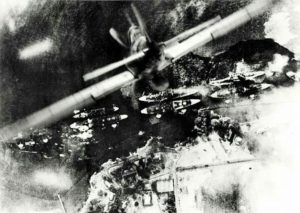
A japanese bomber soars up and over battleship row after releasing its payload.
In the aftermath of the Sunday morning attack, all 8 US Navy battleship were damaged with 4 sunk. The Japanese also sank 3 destroyers, 3 cruisers, 1 minelayer, and an anti-aircaft training ship. 188 US aircraft had also been destroyed in the attack; 2,403 Americans were killed, and another 1,178 others were wounded. By attacking the US Pacific fleet at Pearl Harbor, the Japanese had hoped to prevent the United States from interfering with its planned military campaigns in Southeast Asia and elsewhere. One day after the devastating attack on Pearl Harbor, the United States declared war on the Empire of Japan.
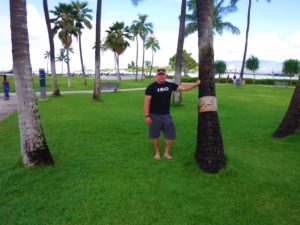
Big John at Pearl Harbor Memorial, Hawaii
Blessed with the opportunity to spend a considerable amount of time on the island of Oahu, I made it my priority to explore the Pearl Harbor Memorial, as well as other areas directly affected by the December 7 attack. These are just a few of the photos I captured along the way. It was my intention that these photos cause readers to pause and reflect on this momentous event that led the United States into World War II.
Although some of the sites at the Pearl Harbor Memorial are paid attractions, the USS Arizona Memorial is entirely free. If you plan on visiting the site, I highly recommended that you get there as early in the morning as possible as the tickets to the USS Arizona are all on a first come – first serve basis. The later it is that you reach the park, the longer it is that you will most likely have to wait. While waiting your turn to see the USS Arizona, there are a number of museum-quality displays to explore, as well as the USS Bowfin submarine, and a gift shop and cafe.
Going out to the USS Arizona is a very solemn experience. First visitors will be ushered into a theater where they will watch a moving documentary of the Pearl Harbor attack on a large screen. After the film, visitors will board a boat where US Navy sailors will take them out to the wreckage. During the entire tour of the USS Arizona, all talking and texting is highly discouraged. Photographs are encouraged and permitted.
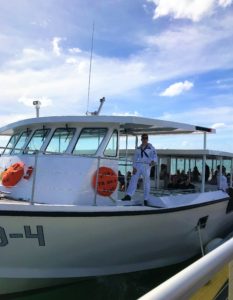
US Navy sailors ferry visitors to and from the USS Arizona
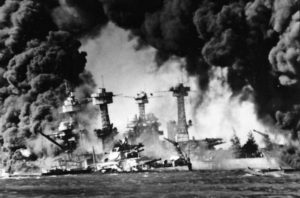
Battleship USS West Virginia sunk and burning at Pearl Harbor on Dec. 7, 1941. In background is the battleship USS Tennessee.
The USS West Virginia was hit with seven type 91torpedoes on her port side while bombers struck her with a pair of 16 in (410 mm) armor piercing shells. The ship was sunk but did not capsize. The crippling damage to the USS West Virginia caused it to sink upright to the harbor floor During the attack, 106 sailors lost their lives. The USS West Virginia was eventually repaired and saw action during many World War II battles in the Pacific.
Survivors of Pearl Harbor described the scene as a literal hell on earth. Everywhere there were explosions, screams and fire. Sailors jumped from their ships into the harbor, covered in oil and fully engulfed in flames. All the while, Japanese planes continued their onslaught while brave sailors, Marines, and aviators tried to repel their attack.
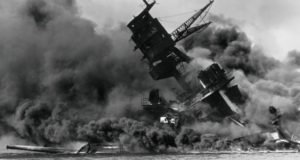
The USS Arizona (BB-39) explodes violently as a Japanese bomb detonates inside a powder magazine.
For 1,177 officers and crew of the USS Arizona, there would be no future war stories to be told. For the men that died aboard the USS Arizona, the war ended even before it had begun. Unlike many of the other ships that were sunk on December 7, 1941, the USS Arizona was well beyond repair. The wreckage of the ship, along with her valiant men, still lie at the bottom of Pearl Harbor.
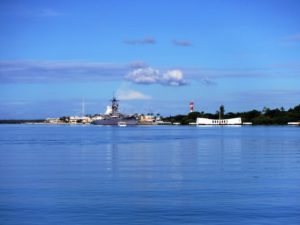
The USS Arizona Memorial with USS Missouri in the background.
The USS Arizona Memorial is an actual gravesite as many sailors are still entombed inside the hull of the ship. The memorial was designed by Alfred Preis, an Austrian-born architect who was sent to a US internment camp after the Pearl Harbor attack.
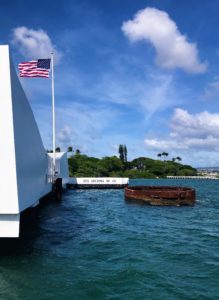
Although the memorial is positioned directly over the wreckage of the USS Arizona, no part of its structure actually rests on the ship.
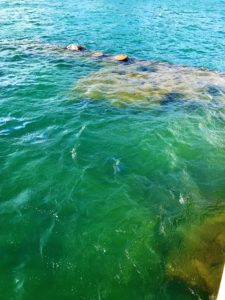
To this day, considerable amounts of oil from the ship still seep to the water’s surface.

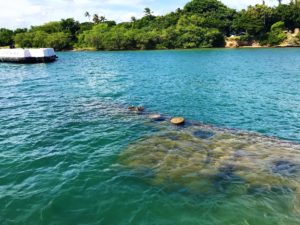
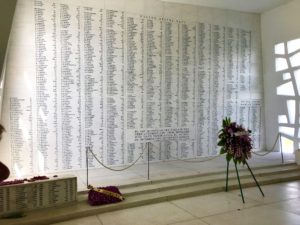
The names of all lost who served aboard the USS Arizona and lost their lives on December 7, 1941.
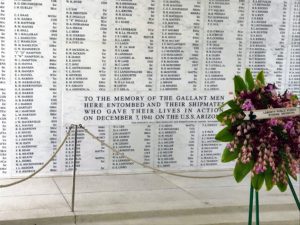
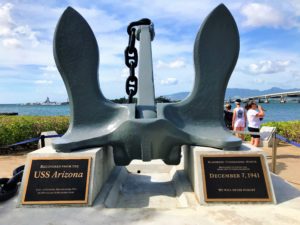
An actual anchor belonging to the USS Arizona that was recovered in Pearl Harbor.
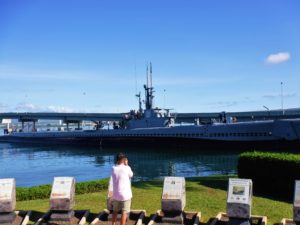
The USS Bowfin (SS-287), a Balao-class submarine, saw action in the Pacfic and is now moored at Pearl Harbor, HI.

The lone sailor now stands watch over Pearl Harbor and is a tribute to all those who served in the sea services.
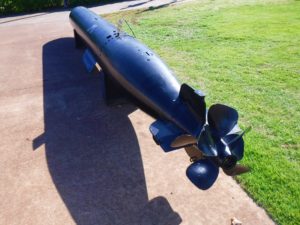
A WWII era torpedo
Prior to the attack on Pearl Harbor, American Naval Command believed that Pearl Harbor was too shallow for a successful torpedo attack. In planning their operation, the Japanese modified their torpedoes to operate effectively in only about 40 feet of water. The Type 91 torpedo, which was deployed in the attack, was an aerial torpedo designed to be launched from an airplane. The torpedo’s wooden stabilizers were shed from the tail fins immediately upon water entry and the weapon power-glided towards its target just below the water’s surface.

Map showing the December 7, 1941 attack on the island of Oahu.
The Pearl Harbor Naval Base wasn’t the only thing on Oahu attacked on December 7, 1941. The Japanese also struck Schofield Barracks, Wheeler Army Airfield, Hickam Airfield, Bellows Field, Naval Air Station Kaneohe Bay, and Ewa Mooring Mast Field. Along with the numerous military personnel killed and wounded, there were also 49 civilians who lost their lives that day.
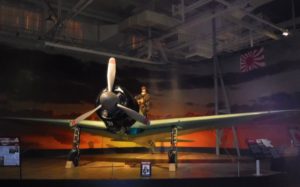
A restored Japanese Zero at the Pearl Harbor Aviation Museum on Ford Island, Hawaii.
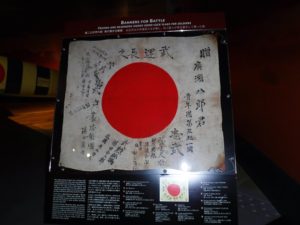
Many Japanese pilots carried these “good-luck” banners with them inside the cockpits of their planes.

Actual wreckage from a Japanese fighter plane.
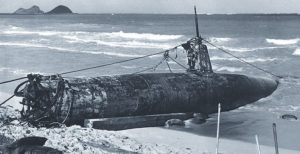
On December 8, 1941, Sakamaki became the first Japanese prisoner-of-war as he stumbled out of his beached mini-submarine at Bellows Air Station, Hawaii.
Sakamaki was commanding a 79-foot submarine armed with twin 18-inch torpedoes. His mission to destroy the USS Pennsylvania was cut short when it got stuck on reefs at Belllows Air Station and them bombed by US piloys patrolling the area.

My son, Jonah, stands in the same spot the Japanese submarine washed to shore.
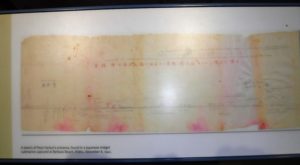
This map was found in the beached submarine showing the entrance to Pearl Harbor.
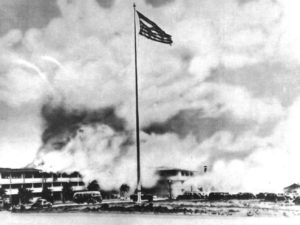
The big barracks at Hickam Field was set ablaze after being strafed and bombed by Japanese aircraft.
During the attack on the barracks, a bomb directly struck the mess hall during breakfast and killed 35 men. In total, the casualties on Hickam Field totaled 121 men killed, 274 wounded and 37 missing.

Today, the Hickam barracks serve as the Headquarters for the Pacific Air Force.
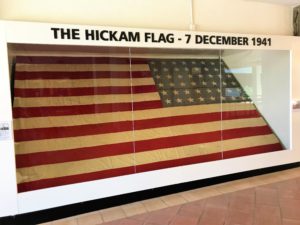
This flag, which once flew proudly over Hickam barracks, was rescued from destruction on the day of infamy.
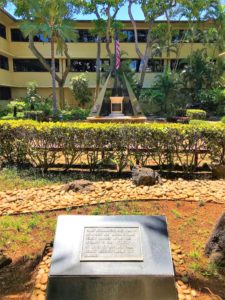
The Courtyard of Heroes inside the courtyard of the Pacific Air Force Headquarters Building (formerly Hickam barracks).
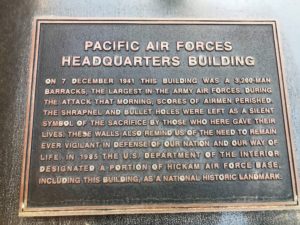

Those that view the bullet holes and shrapnel damage to these walls are reminded to always stay vigilant.
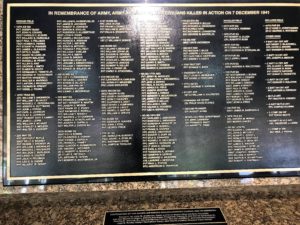
A wall of remembrance at the Pacific Air Force Headquarters Building
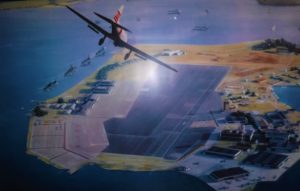
A Japanese dive bomber aims for the runway at Ford Island and Battleship Row.
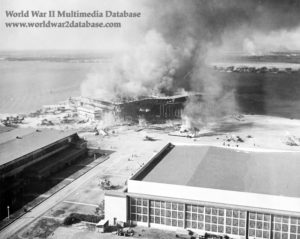
Tora! Tora! Tora! (Photo courtesy of www.worldwar2database.com)
This view was captured from from the top of Ford Island’s control tower as Hangar 6 burned after being struck by multiple bombs. Men can be seen pushing planes away from the carnage while trying to fight back the flames. Imperial Japanese Navy Captain Mitsuo Fuchida broadcasted the words, “Tora! Tora! Tora!” (Tiger! Tiger! Tiger!) to signal a successful surprise attack. Captain Fuchida later recalled, “When Lieutenant Commander Takahashi and his dive-bombing group mistook my signal and thought we were making a non-surprise attack, his fifty-three planes lost no time in dashing forward.”

The tower on Ford Island as it appears today.
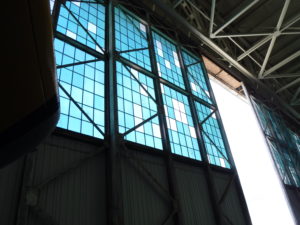
These glass panes still carry bullet holes from the December 7, 1941 attack.
The Pearl Harbor Aviation Museum on Ford Island houses a Boeing B17 Flying Fortress. Visitors to the museum can see this heavy bomber, along with many other planes that helped America win the war in the Pacific.
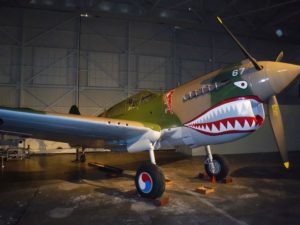
The Curtiss P-40 Warhawk was one of WWII’s most famous fighters.
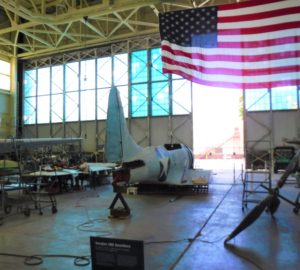
This Douglas SBD (slow-but-deadly) Dauntless was the navy’s premier dive bomber of that day.
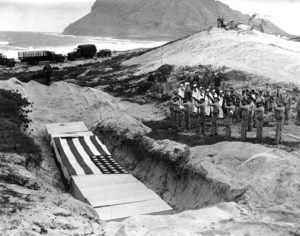
This massive burial ceremony was performed for the men killed at NAS Kaneohe Bay during the December 7th attack.
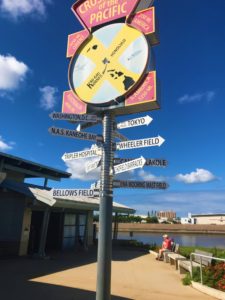
This signpost represents the crossroads to war in the Pacific.
Following the vicious attacks on Pearl Harbor, nearly every able-bodied American rushed to the recruiting office to do their part for the war effort.
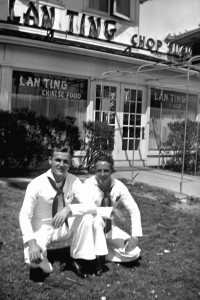
My maternal grandfather, Robert Triebull, (on the right), crouches for a snapshot outside the Lan Ting restaurant, Waikiki, Hawaii.
Robert Triebull enlisted in the navy. He drove Marines to shore on landing craft (LCVP) during seven major battles in the Pacific. Click on the following link to read more of his story:
Diary of a Higgins Boat Sailor in the Pacific
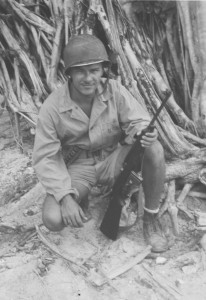
My paternal Grandfather, Richard Cutler, serving as a Marine in the jungles of the Pacific.
Richard Cutler joined the Marines when the war broke out. He served as a rifleman and also played the saxophone in the Marine Corps band. Read more of his story by clicking this link:
A Leatherneck with a Saxophone Takes to the Pacific

Many scenes from the Pacific Theater can be revisited at Pearl Harbor Memorial.
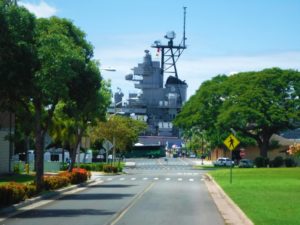
The USS Missouri (BB-63) is now permanently moored at Ford Island, Hawaii, USA.


Signing an end to WWII aboard the USS Missouri Battleship.
On September 2, 1945, the Japanese joined with allied forces aboard the battleship USS Missouri (BB-63) to sign the Instruments of Surrender. This event marked the allies’ victory over Japan and the ended the war.

Big John takes his mother to meet Sterling Cale, one of the last remaining survivors of the Pearl Harbor Attack.
Sterling Cale is a true American Hero. He went on to survive the attack on Pearl Harbor, only to serve again in both the Korean War and Vietnam. On the day of our visit, Sterling Cale was at the park signing autographs for his inspiring autobiography.
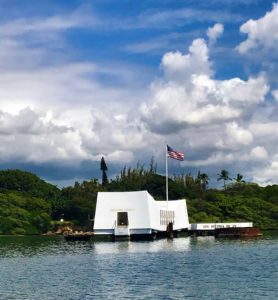
Remembering Pearl Harbor
Through the passing of time, historical events can become so distant that they adopt an almost abstract quality to them. In remembering Pearl Harbor, I hope we always remember that the men that died there, and those men and women that ultimately served and sacrificed in the Second World War, were not some abstract figures in some bygone, abstract event. The attack on Pearl Harbor – the day that will live in infamy – involved the very heart of America, our very own families and friends.
Happy travels,
Big John
Posted in North America, Historical Journeys and tagged Hawaii, Oahu, pearl harbor, WW2 by Big John with 1 comment.